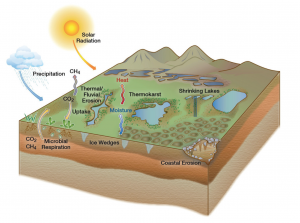After the thaw

Thawing permafrost can release carbon dioxide and methane through microbial respiration. The thawing also produces polygon-shaped patterns of lakes. The complexity of these interactions – and many others – contributes to the challenge of simulating the overall climate change. (Illustration: Diana Swantek from the Earth Sciences Division at Lawrence Berkeley National Laboratory.)
PFLOTRAN also relies on the PETSc (pronounced pet-see) toolkit, a suite of routines and codes to manage parallel data structures, step calculations through time and solve equations. With PETSc, researchers can build scientific computations out of components that will run well even as the computers they run on get bigger. In particular, PETSc provides massively parallel routines for handling partial differential equations, Mills says.
“PFLOTRAN is created from these PETSc building blocks,” he says, “and using PETSc has been critical to our success.” The toolkit solves linear and nonlinear calculations that arise from breaking equations modeling continuous activities, like flow, into components for parallel processing.
Combining with Climate Code
Mills and his colleagues presented some of their PFLOTRAN progress last October at the Geological Society of America’s annual meeting in Denver. The team noted that previous climate-change models ignored – or at least oversimplified – many hydrological processes, especially ones involving permafrost, such as increasing thaw.
Permafrost could play a crucial role in Earth’s climate. Its thaw allows once-frozen organic material in the soil to decompose and emit carbon dioxide and methane. Those gases could drive more warming, generating more permafrost thaw and still more warming. Moreover, this feedback loop could be nonlinear driving more warming than might be expected.
How much change could thawing permafrost create? No one knows, but Mills and others hope PFLOTRAN can provide some answers. To get there, though, the code must be incorporated into Earth system models designed to simulate the entire collection of processes that affect climate.
At the GSA meeting, Mills also described coupling PFLOTRAN with the Community Land Model (CLM), which is part of the Community Earth System Model (CESM).
Seeking the Right Scale
Gautam Bisht, a scientist in the Climate Sciences Department at Lawrence Berkeley National Laboratory, developed that combined code, PFLOTRAN-CLM, while working as a post-doctoral fellow with Mills. The code will be used in the NGEE (Next Generation Ecosystem Experiments) Arctic program, supported by the DOE Office of Science Biological and Environmental Research program. “NGEE Arctic is a 50-50 split across modeling and field observations,” Bisht says. “There’s a very large team going into the field around Barrow, Alaska, and measuring fluxes of carbon dioxide and methane on a very fine scale.”
The field teams are collecting data within four intensively monitored 1,000-meter square grids. “Then we’ll try to model the processes at that scale,” Mills says. PFLOTRAN-CLM also will model data researchers collect on a more coarse scale. Eventually, the code will be used to model even larger areas, perhaps 100 kilometers across. “The end goal of the project,” Bisht says, “is to develop a model that provides better predictions of the impacts of climate change.”
The large simulations will require high-performance computers. The NGEE Arctic team has an allocation of 30 million core-hours on Mira, an IBM Blue Gene/Q at Argonne National Laboratory. Those hours will be used to find the right scale for the permafrost simulations, but much more work lies ahead.
Mills says the team will start by looking at moisture in the cells and then move to the biogeochemistry. Step by step, they hope to get changing permafrost into the overall climate models.
Adds Mills, “I’ve worked on lots of complicated things, but this is the most complicated.”
About the Author
Mike May has worked as a full-time freelancer since 1998, covering topics ranging from biotech and drug discovery to information technology and optics. Before that, he worked for seven years as an associate editor at American Scientist. He earned an M.S. in biological engineering from the University of Connecticut and a Ph.D. in neurobiology and behavior from Cornell University.




